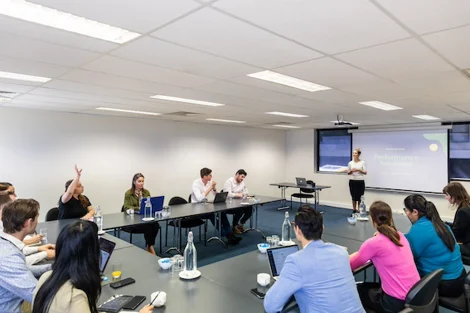
How Technology in the Workplace Has Shaped Professional Arrangements
SHARE

The global shift towards remote working has made it crystal clear just how reliant we are on technology in the workplace. Over the last year and a half, we have become completely dependent on a whole host of technologies—from new communication systems to automated workflow software, and big data infrastructure.
In short, we’re never going back.
But it’s important to recognise that whatever radical change has occurred in the last year and a half, it wasn’t totally out of the blue. Much of the technology that we have come to rely on when working from home was already out there, waiting to be taken up in larger numbers. The technological seeds had already been planted for a major overhaul of the way we communicate and organise ourselves at work—and away from it. The pandemic just sped things up a bit (a lot).
In this article, we take a look at exactly how technology has reshaped the modern office workplace over the last decade. We will identify key historical milestones and current trends, and we will also consider exactly how workplace technology has facilitated higher levels of business performance and workplace wellbeing.
A Brief History Of Workspace Technology
From the introduction of personal computers to office spaces in the 1970s to the takeoff of the internet in the 1990s and the big data boom of the 2000s, workplace technology has come a long way over the last 50 years. But as happens with technology, progress is exponential.
Consequently, the last ten years have seen some astounding changes that have profoundly shaped the way we work. Let’s have a brief look at the biggest technological milestones of that period.
Remote Work Technology
In terms of the way businesses function day-to-day, perhaps the biggest technological change of the last ten years has been the explosion of software that facilitates remote working.
The proportion of people working remotely has simply exploded. A report produced by the business app GetApp released last year suggested that remote work has risen by 400% in just ten years.
That’s obviously an exceptional fact in its own right, but it’s important to recognise that this kind of explosion just couldn’t have occurred without the development of more powerful remote working technologies. Of obvious importance here are communication technologies like Microsoft Teams and Zoom.
But more significant than these video technologies is the development of dedicated collaboration software like Slack, Asana, and Microsoft 365. It’s not just about being able to hold a meeting from home. It’s about everybody being on the same page and working together in real-time.
A survey of 1,200 IT decision-makers undertaken earlier this year by Slack’s research team found that 78% of respondents would continue to use collaboration software even after work arrangements turn back to normal. That’s a significant increase on the less than 50% who used it before.
This is not surprising, given that all the evidence points to the idea that flexible working arrangements are here to stay.
The Cloud
At the turn of the last decade, we witnessed a pivotal turn in office work technology, namely through the proliferation of cloud computing technology. It was in 2010, for example, that Microsoft brought its Microsoft Azure system to market, and it was also in 2010 that NASA and Rackspace Hosting brought out the open-source project known as OpenStack.
Cloud computing is not so much a discrete technology that was invented at this time. But through key systems releases like those noted above, it was during this period that corporate organisations went through their own technological shift towards cloud computing.
The basic concept of cloud computing is that computing resources can be accessed remotely—that is, without the need for localised storage of data and software. The upshot of this technology for the way we work is that team members can access the same files from wherever they are, whether that’s at work, at home, or on the road.
One simple example of how cloud computing revolutionised office work was that it made the transportation of files (i.e. through hard drives and USB drives) obsolete. But this is just the tip of the iceberg.
The cloud was not just about making it easier for individuals to access their own files. It was also about letting multiple stakeholders access common files simultaneously. One of the most well-known examples of this trend might be the evolution of Google Docs, as well as other Google file types.
Whether team members are working in different locations throughout the city or just at different hot desks in the same office space, cloud computing has made it easier for organisations to collaborate in real-time.
More than just helping with file storage, the cloud also made it possible for workers to access an organisation’s software remotely. The development of corporate services like Amazon Web Services made it possible for software to be stored remotely and accessed on-demand using simple login protocols.
In practice, this has meant that software like accounting systems and workflow tools don’t need to be stored locally in office spaces anymore. Instead, they can be accessed via the cloud from a cafe, a bedroom, or a satellite office.
Finally, cloud computing has also had the effect of radically reducing the up-front costs of IT infrastructure. This has meant that it is much easier for new companies to get up and running, and also much easier for existing companies to be mobile. While many larger companies had some kind of cloud computing in place before the 2010s, it was during that decade that such software first became accessible to smaller businesses.
The Internet of Things
The Internet of Things is a strange-sounding term that can conjure some exotic imagery. Indeed, the development of the Internet of Things has made some weird and wonderful things possible, such as robots (including drones) transmitting real-time data to AI hubs in Amazon warehouses.
But the Internet of Things holds far more simple—but no less revolutionary—applications in office spaces. In essence, the Internet of Things denotes the way in which devices are connected to one another via the internet. This includes everything from laptops to mobile phones, printers, phone systems, and garage door openers.
The principle behind this technology is that, as more and more devices become connected, it becomes easier and easier to streamline business operations. This is because the connected devices are capable of automatically sending information to one another.
Take, for example, a company operating in the retail sector. The Internet of Things allows for the real-time collection of data from devices like smart shipping containers and delivery vehicles. But most impressively, the Internet of Things allows for these devices to automatically transmit their data to office workers thousands of kilometres away, who can then make decisions in real-time about actions to be taken along the supply chain.
Just like cloud computing, the Internet of Things is not a technology that was invented in the 2010s, but this really was the period in which it made a difference. Cisco Systems research suggests that it was between 2008 and 2009 that the Internet of Things was ‘born’. It was during this period that the number of connected devices around the world surpassed the number of the earth’s human inhabitants.
But it was in the following decade that the real gains were made and the material influence was most strongly felt. In 2010, there were 12.5 billion connected devices. By 2020, that number had quadrupled to 50 billion.
The result of this boom is that, now, when you walk into an office space, most of the devices in the room are working in tandem, and they’re also communicating with a great number of devices that aren’t in the room.
Virtual Office Technology
Another major change arising from the previous decade of workspace technology was the development of virtual office space. As with some of the other technologies we have spoken about so far, the virtual office really took off at the end of the decade, at the onset of the Covid-19 pandemic. But the trend was already in motion before that.
The basic concept of a virtual office is that the physical environment of an office is simulated as far as is possible when teams are working remotely. Of course, the development of meeting room technology like Zoom and Microsoft Teams during the early 2010s allowed for virtual meetings to take place between team members working from home or from satellite offices. But the possibilities of a virtual office space are more far-reaching than this.
As the decade progressed, virtual offices started to offer resources that recreated physical office environments with greater fidelity. On the one hand, video technology has come a long way since the days of Skype dropping in and out ten times during a 30-minute call. Now, the leading virtual office technologies allow for constant video connection throughout the workday—teams can call ad-hoc meetings on-demand or use breakout rooms to chat in smaller groups or pairs.
The video technology is also supported by live chat systems, allowing team members to communicate with one another on a social level at the same time as working. It’s important to remember that coworking technology programs like Slack or Teams can’t settle for facilitating just work. They also have to find a way to recreate that vital social dimension of physical office spaces. Employees need to be able to have a laugh, unwind, and encourage one another throughout the workday.
Technology, Wellbeing, and Productivity
The advance of technology can often be thought of as a kind of sterile and lifeless phenomenon. Cue the comments about how artificial intelligence and automation will soon turn workplaces into ghost towns, or places in which people are controlled by machines. (In fact, all the evidence suggests that AI and automation are likely to create more jobs than they will take away.)
But the truth about the technological advances of the modern office space is that people are at the very heart of the change. Bringing in new technology holds the obvious benefit of making businesses more productive by streamlining operations and cutting out the need for time-consuming manual tasks. But technology also has the capacity to make workspaces more engaging and enjoyable for workers. Of course, with higher levels of employee satisfaction, businesses also stand to benefit from greater productivity.
Win-win.
Technology and Wellbeing
So, how might technology assist in bringing more soul to the workplace?
Well, take the example of virtual office software that we have just been talking about. As the global pandemic has made clear, remote working arrangements do have the potential to break down the social dimension of an office space—working from home can be quite isolating. But the development of virtual office software has served to fight against this and improve employee wellbeing.
In virtual office spaces, employees have the capacity to message each other instantly and regularly, and they also have the chance to drop in and out of video conversations with ease. This may seem like a fad with no real impact on employee wellbeing.
But it’s not.
A report released by consultancy firm Deloitte shows, for example, that the median level of employee satisfaction rises by 20% when companies have social networking technology in place. It was also found that employees reported a strong preference for new social communication tools like instant messaging over more traditional communication channels like email or online workspaces. The same report also suggested that employee access to social networking technology increased productivity by 7%.
This translation of employee wellbeing into higher productivity is no secret. Countless studies have shown that happy workers are better workers. A highly respected study carried about by Oxford University in 2019 found, for example, that when employees were happy and satisfied with their work environment, they were 13% more productive.
The equation is simple. The more technology brings people together at a social level, the more it enhances productivity.
Technology and Productivity
It’s hard to exhaustively cover all the ways in which new workplace technologies are generating higher levels of productivity. But we can break them down into a few key dynamics:
- Technology improves communication
- Technology can streamline workflows
- Technology can allow us to work smarter
Let’s have a look at these in more detail.
1. Communication
Well, we’ve already seen how improved communication technologies can make workers feel more connected, improve their wellbeing, and indirectly increase productivity. But communication technology can boost business performance in more direct ways.
For one, when organisations have good communications systems in place, information is transmitted faster and with greater clarity. Simple.
By way of evidence, a McKinsey Global Institute report suggests that when companies integrate communication and collaboration technologies into their operations, the productivity of workers increases by between 20 and 25%.
Another report by the Institute of Corporate Productivity found that companies that used Slack sent 49% fewer emails, had 25% fewer meetings, and reported a 32% increase in productivity. These figures give some insight into exactly how communication technologies can improve productivity—it’s not so much that these tools provide for more communication as they do better communication.
2. Streamlining Work
Closely related to the improved communication that new workplace technologies provide is the way in which they can streamline workflows. By this, we mean that the work that businesses undertake can be done more collaboratively and efficiently.
At one end of the scale, you have dedicated workflow management tools like ProofHub, Nintex, or Zapier. Such software systems allow teams to do things like automatically assign tasks based on role designations, create transparent task prioritisations, and generate productivity reports. They can be powerful tools when used appropriately.
But there are simpler ways in which technology can streamline work. Take an example we have already considered—cloud computing. Cloud storage allows team members to access and work on shared files simultaneously, facilitating fast collaboration and stopping productivity bottlenecks from forming.
3. Smarter Work
Lastly, technology can help businesses work smarter by cutting out a lot of time-consuming manual tasks.
There are many simple ways in which this can occur. Technology is now fit to automatically crunch numbers and communicate with clients and customers, for example. Also, a lot of administrative tasks like maintaining meeting schedules, processing payments, and documenting incoming information now no longer needs to be done manually. There is software for everything.
At the other end of the spectrum of possibilities, you have AI technologies that can perform the kind of business analysis that usually only the largest firms can afford—both in terms of time and money.
As AI technology develops, it is becoming cheaper and more accessible. Now, it’s possible for small firms (assuming their processes are digital) to analyse their own productivity. As the big firms have known for a long time now, having access to this kind of information not only improves the productivity of existing processes but also assists with the identification of emerging opportunities.
Living in the Future
What we’ve seen throughout this article is that, in the last ten years, new technologies have completely reshaped the way we think about work. From taking office spaces virtual to automating workflows and giving us on-demand access to powerful computational tools, technology has altered pretty well every aspect of business operations—and we’ve only considered a handful of examples.
But what’s so interesting about all of this change is that, right now, things are moving at a faster rate than ever before. The last year and a half have accelerated a process of change that probably would have taken another ten years to play out. In effect, then, we are living in the future.
The measure of our success will be how quickly we can catch up.



